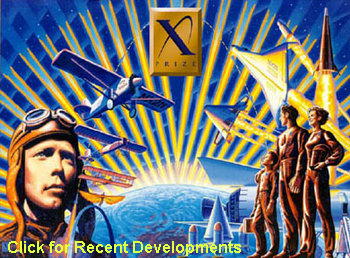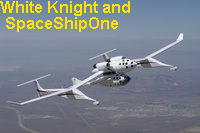
Recent Developments
There are two foreseeable solutions to phasing out the old and expensive space shuttle programs: space tourism and private sector promotional programs such as the Ansari X-Prize.
On April 28, 2001, the first space tourist, Dennis Tito, paid $20 million dollars to fly to the International Space Station by the Russian Space Program on Soyuz TM-32. (Wikipedia, 2004) Allowing for space tourism would help space programs afford to fund an increased number of missions at lower costs to federal funds. In addition, to prevent the extremely rich from dominating the market for tourism, a national lottery could be set into effect to allow a few hundred citizens to be trained as astronauts and provided the opportunity to travel to space.
Also, promotional programs like the Ansari X-Prize would yield more efficient privately designed and owned modern shuttles or space planes. In the last eight years, several designs have been proposed and tested for the
 Ansari X-Prize. On
June 21, 2004, SpaceShipOne owned by Scaled Composites, LLC was the first
privately developed manned spaceship to reach into space. (Wikipedia, 2004) This
same ship won the Ansari X-Prize October 4th (last month) winning the $10
million reward. (Ansari X-Prize, 2004) Most recently, Richard Branson announced
the launch of Virgin Galactic which will use SpaceShipOne technology to build
taxi-spacecraft with the intentions of launching commercial flights as early as
2008.
Ansari X-Prize. On
June 21, 2004, SpaceShipOne owned by Scaled Composites, LLC was the first
privately developed manned spaceship to reach into space. (Wikipedia, 2004) This
same ship won the Ansari X-Prize October 4th (last month) winning the $10
million reward. (Ansari X-Prize, 2004) Most recently, Richard Branson announced
the launch of Virgin Galactic which will use SpaceShipOne technology to build
taxi-spacecraft with the intentions of launching commercial flights as early as
2008.

From here on out, there is only room for progress. With the People's Republic of China catching up with Russia and the United States, other countries are bound to follow suite with time. The Ansari X-Prize will live on as the annual Ansari Cup open to the world to continue competing. With advancements in spacecraft designs and technology, regulated space tourism will surely be a
reality in the near future. With public interests in space travel and exploration, further advances in technology, and a revenue for space tourism, international space programs and private industries alike will be able to pursue more and more missions reaching out and discovering our extraterrestrial surroundings. Through observations only available through advancements in technology, scientists will learn more and more about the laws governing the nature of our galaxy and the Universe.